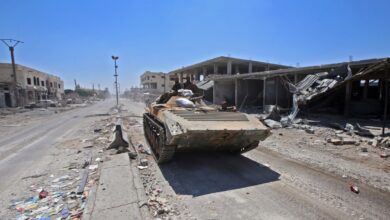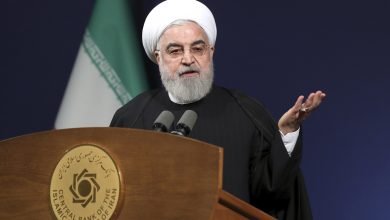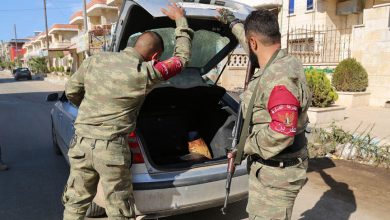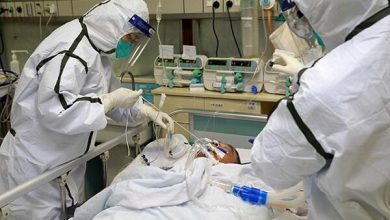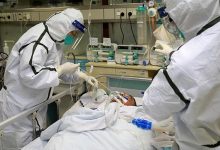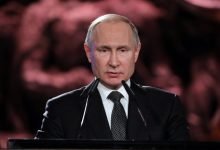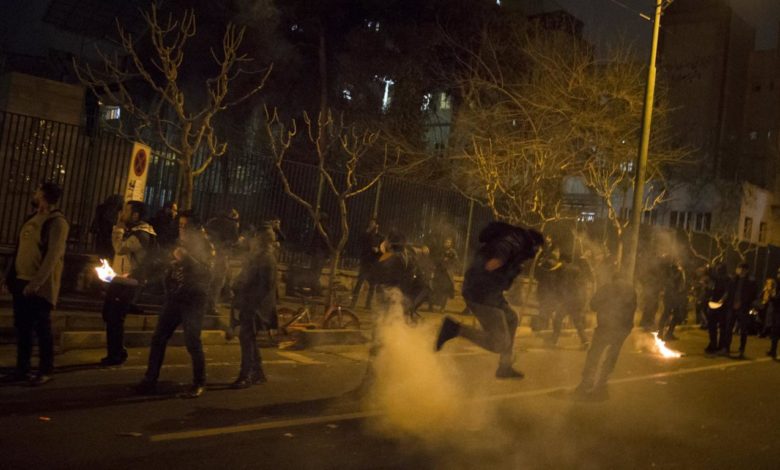
Iran was facing a renewed crisis on Sunday night with authorities using teargas to break up a second straight day of protests in Tehran and demonstrations spreading to other cities, as the nation’s leadership struggled to contain public anger over the Iranian military’s shooting down of a commercial airliner with 176 people on board.
Britain also found itself caught up in the furore as pro-regime protesters set alight a union jack flag in front of the UK embassy in Tehran after the British ambassador was briefly detained the night before and accused of coordinating protests, which he denies. Chanting “death to Britain”, up to 200 protesters including members of a pro-regime paramilitary organisation rallied outside the mission calling for it to be closed a day after Rob Macaire was arrested. He was later summoned by the Iranian foreign ministry.
Despite a heavy security presence on the streets of the capital, small protests flared up at several universities in Tehran throughout Sunday against both the shooting down of the Ukraine International Airlines jet last Wednesday and the subsequent days of official denials that an Iranian missile was responsible.
“They tell us the lie that it is America, but our enemy is right here,” a crowd shouted at Tehran’s Shahid Beheshti University, and compared the Revolutionary Guards and their paramilitary allies to Islamic State. “You’re our Isis,” they said.
Footage posted online showed demonstrations taking place in other cities including Tabriz, Shiraz and Kermanshah.
As the sun went down, columns of security vans, including some fitted with cages, were seen streaming towards Tehran’s Azadi Square. Several hundred protesters also made their way there, marching through subway stations and along streets, singing revolutionary anthems and chanting, “death to the dictator”.
Later footage showed flood lights illuminating teargas in the air and protesters wearing cloths across their mouths as they continued to chant anti-regime slogans. “They fired teargas in the Azadi subway station,” said a man in one clip. “No one can get out, everybody is getting suffocated.”
Another video from Tehran showed a trail of blood on a sidewalk. “I saw seven people shot,” said a male voice holding the camera. “There is blood everywhere.” The veracity of the footage could not be independently confirmed.
The resurgent anti-government protests threaten to tip Iran’s regime into crisis just as it was riding a wave of nationalist sentiment after the killing of top general Qassem Suleimani by a US drone strike on 3 January.
Iran’s response – a carefully calibrated but heavily publicised ballistic missile attack on US forces in Iraq last Wednesday – was supposed to bring catharsis and demonstrate the regime’s power.
Instead, by leading to the shooting down of a passenger jet loaded with Iranian citizens, it has humiliated the military and exposed some of its top leaders as having lied to the country for days until the admission on Saturday morning that an Iranian missile was responsible for the crash.
Two state TV hosts resigned in protest over false reporting over the incident and Iranian media outlets joined the outcry, running front-page headlines that read, “Ashamed” and “Unbelievable”.
Iranian officials on Sunday defended the brief arrest of Macaire, the UK’s envoy to the country, saying he was “arrested as [an] unknown foreigner in an illegal gathering”.
“When police informed me a man’s [been] arrested who claims to be UK amb[assador], I said IMPOSSIBLE!,” wrote Seyed Abbas Araghchi, the deputy foreign minister, on Twitter. “Only after my phone conversation w[ith] him I identified, out of big surprise, that it’s him. 15 mins later he was free.”
Macaire tweeted that he had attended what was advertised as a vigil, left as it began to turn into a protest and was detained half an hour later. The Tasnim news agency, which is linked to Iran’s Revolutionary Guards, reported on Sunday that Macaire had been using a shop near the protests as a place of “coordination”.
A few dozen members of the Basij paramilitary group gathered outside the UK embassy calling for its closure.
The British foreign secretary, Dominic Raab, condemned the ambassador’s arrest as a “flagrant violation of international law” and said Iran was marching towards “pariah status”.
Donald Trump used the unrest to intensify pressure on the Islamic Republic and declare his support for the demonstrators. “DO NOT KILL YOUR PROTESTERS,” Trump said in a tweet direct at the Iranian government. “The World is watching. More importantly, the USA is watching.”
Suffocating US sanctions have sent Iran into deep recession, and a hike in the official price of fuel in November led to the largest protests in the 40-year history of the regime, to which the government responded by walling off Iran’s internet for several days and killing hundreds of demonstrators.
On Sunday, in a meeting between Iranian president Hassan Rouhani and the visiting emir of Qatar, both sides agreed de-escalation was the “only solution” to the regional crisis, the emirate’s ruler said.
Emir Sheikh Tamim bin Hamad Al-Thani said: “We agreed … that the only solution to these crises is de-escalation from everyone and dialogue.”
The leaders of the UK, France and Germany on Sunday issued a joint statement calling on Iran to return to full compliance with a 2015 nuclear deal with world powers and refrain from further violence.
“We urge Iran to reverse all measures inconsistent with the agreement and return to full compliance,” the leaders said in the statement issued by the office of the French president, Emmanuel Macron.
Iran had been complying with the deal until the US unilaterally pulled out in May 2018, imposing the sanctions that had incentivised Tehran to give up its nuclear program. Since then it has gradually walked away from the agreement in incremental steps that reduce the time it would take for the country to develop a nuclear weapon, although it maintains its nuclear research is peaceful.
“We call on Iran to refrain from further violent action or proliferation; and we remain ready to engage with Iran on this agenda in order to preserve the stability of the region,” the joint statement added.
The Revolutionary Guards commander, Hossein Salami, said on Sunday his forces were “more upset than anyone” over the shooting down of the plane, but other officials accused the US and its allies of exploiting the tragedy.
“Iran’s enemies want to take revenge on the Guards for a military mistake,” said Ali Shirazi, a representative of the Quds force, the Revolutionary Guards’ external arm.
The victims of the crash include 82 Iranians, 63 Canadians, 11 Ukrainians, 10 Swedes, four Afghans, three Germans and three British nationals.


